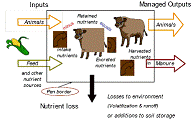Biological Systems Engineering, Department of

Department of Agricultural and Biological Systems Engineering: Presentations and White Papers
ORCID IDs
Heeren 0000-0002-0222-5516
Mohammed 0000-0003-2552-1155
Neale 0000-0002-7199-6410
Amori 0000-0001-8104-0394
Goncalves 0000-0002-8070-9292
Balboa 0000-0003-3819-5088
Date of this Version
3-2024
Document Type
Article
Citation
Technical report submitted to the Eastern Nebraska Research, Extension, and Education Center, 2024
Department of Biological Systems Engineering, University of Nebraska-Lincoln
Abstract
Long-term irrigation management research has been conducted from 2014 to 2023 for corn and soybean at the Eastern Nebraska Research, Extension, and Education Center (ENREEC) Variable Rate Irrigation (VRI) Field located in subhumid east-central Nebraska (in the Lower Platte North Natural Resources District). The objective of this report was to present the overall results from the VRI Field for 2021 to 2023. Across the three growing seasons, there were the following irrigation treatments: Best Management Practice (BMP), 50% BMP, 125% BMP, rainfed, Spatial ET Modeling Interface (SETMI), SDD1, SDD2, machine-learning-based Cyber-Physical System (CPS), a student team recommended rate, and industry trials from Irriga Global’s Aluvio. Results showed that from 2021 to 2023, only 2022 was dry enough to have a significant yield response to irrigation in both corn and soybean. The distribution of precipitation in 2023 resulted in a significant difference in yield for corn but not soybean. Over 9 years of corn production, the mean seasonal irrigation was 4.4 in (for full irrigation treatments), corresponding to a mean yield of 246 bu/ac compared to a mean rainfed yield of 227 bu/ac. For 8 years of soybean research, the average seasonal irrigation was 4.0 in; the mean irrigated soybean yield was 70 bu/ac compared to 66 bu/ac for rainfed plots. The long-term average increase in gross revenue (from irrigation) was 104 $/ac/yr for corn and 46 $/ac/yr for soybean.
Included in
Agriculture Commons, Agronomy and Crop Sciences Commons, Bioresource and Agricultural Engineering Commons, Water Resource Management Commons


Comments
Open access material
License: CC BY-NC 4.0